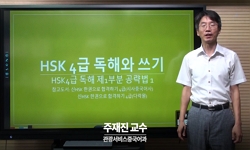Nowadays, Reading comprehension focuses on the content based second language instruction. This paper investigates what kind of information leaners collect as pre-reading activity, and how this information activates learner’s schema at Japanese readi...
http://chineseinput.net/에서 pinyin(병음)방식으로 중국어를 변환할 수 있습니다.
변환된 중국어를 복사하여 사용하시면 됩니다.
- 中文 을 입력하시려면 zhongwen을 입력하시고 space를누르시면됩니다.
- 北京 을 입력하시려면 beijing을 입력하시고 space를 누르시면 됩니다.
https://www.riss.kr/link?id=A103735428
-
저자
임시은 (한국외국어대학교)
- 발행기관
- 학술지명
- 권호사항
-
발행연도
2015
-
작성언어
Korean
-
주제어
일본어교육 ; 독해 ; 스키마 ; 독해 전 활동 ; 배경지식 ; Japanese education ; Reading Comprehension ; Schema ; prereading activity ; background knowledge
-
KDC
830
-
등재정보
KCI등재
-
자료형태
학술저널
- 발행기관 URL
-
수록면
255-272(18쪽)
-
KCI 피인용횟수
0
- DOI식별코드
- 제공처
-
0
상세조회 -
0
다운로드
부가정보
다국어 초록 (Multilingual Abstract)

Nowadays, Reading comprehension focuses on the content based second language instruction. This paper investigates what kind of information leaners collect as pre-reading activity, and how this information activates learner’s schema at Japanese reading class. Reading process can be divided into 3 steps, which are pre-task, reading activity and follow up. If leaners have background knowledge about Japanese literature or cultures before reading, it will be easy to understand contents of the text. Textbook for reading comprehension does not have much information about literature or authors. So, teacher make leaners to investigate about author’s information (including background of life, view of the world, writing style), related materials, or story of literature. This activity can be effective as follows. •Leaners can feel interest in Japanese literature by introducing familiar things. •Author’s view of the world can help learners to understand literature. •Leaners can formulate hypothesis before reading. After the semester, teacher surveyed leaner’s satisfaction about pre-reading activities and the result shows high level of leaner’s satisfaction.
목차 (Table of Contents)
- 1. 서론
- 2. 선행연구
- 2.1 독해・스키마에 관한 연구
- 2.2 독해활동에 관한 연구
- 3. 중급 독해 수업의 개요
- 1. 서론
- 2. 선행연구
- 2.1 독해・스키마에 관한 연구
- 2.2 독해활동에 관한 연구
- 3. 중급 독해 수업의 개요
- 3.1 교재의 구성과 학습목표
- 3.2 수업의 흐름
- 4. 독해 전 활동의 내용
- 5. 독해 전 활동의 기대효과
- 6. 학습자의 만족도
- 7. 맺음말
- [參考文獻]
-
- <要旨>
참고문헌 (Reference)
1 "효과적인 독해교육" 한국일본어교육학회 10 : 63-76, 2006
2 한국외국어대학교 일본어학술도서편찬위원회, "일본어명문감상" 한국외국어대학교 출판부 2013
3 윤강구, "일본어 어떻게 가르칠 것인가" 지식과 교양 232-, 2011
4 이경규, "일본어 독해 교육에 관한 일고찰 - 중급 이상의 독해 교육을 중심으로 -" 한국일본근대학회 (19) : 5-16, 2008
5 国際交流基金, "読むことを教える" ひつじ書房 28-, 2006
6 岡崎眸, "読み方の指導―ボトムアップ的読み方から相互交流的読み方へ―" (49) : 205-218, 1996
7 岡崎敏雄, "日本語教育における学習の分析とデザイン―言語習得過程の視点から見た日本語教育" 凡人社 27-54, 2001
8 岡崎敏雄, "日本語教育におけるコミュカティブ・アプローチ" 凡人社 147-, 1990
1 "효과적인 독해교육" 한국일본어교육학회 10 : 63-76, 2006
2 한국외국어대학교 일본어학술도서편찬위원회, "일본어명문감상" 한국외국어대학교 출판부 2013
3 윤강구, "일본어 어떻게 가르칠 것인가" 지식과 교양 232-, 2011
4 이경규, "일본어 독해 교육에 관한 일고찰 - 중급 이상의 독해 교육을 중심으로 -" 한국일본근대학회 (19) : 5-16, 2008
5 国際交流基金, "読むことを教える" ひつじ書房 28-, 2006
6 岡崎眸, "読み方の指導―ボトムアップ的読み方から相互交流的読み方へ―" (49) : 205-218, 1996
7 岡崎敏雄, "日本語教育における学習の分析とデザイン―言語習得過程の視点から見た日本語教育" 凡人社 27-54, 2001
8 岡崎敏雄, "日本語教育におけるコミュカティブ・アプローチ" 凡人社 147-, 1990
동일학술지(권/호) 다른 논문
-
- 한국일본언어문화학회
- 飯干和也
- 2015
- KCI등재
-
日本人観光客の口コミから見る日韓謝罪文化の比較 -ミスに対して「謝罪がなかった」事例から-
- 한국일본언어문화학회
- 持田祐美子
- 2015
- KCI등재
-
日本語方言談話における受話法について -新潟県下田村方言を中心に-
- 한국일본언어문화학회
- 渡邉有紀恵
- 2015
- KCI등재
-
「マイナス待遇表現のプラス待遇化」 -発話機能と人間関係の相関性を中心に-
- 한국일본언어문화학회
- 金修卿
- 2015
- KCI등재
분석정보
인용정보 인용지수 설명보기
학술지 이력
| 연월일 | 이력구분 | 이력상세 | 등재구분 |
|---|---|---|---|
| 2028 | 평가예정 | 재인증평가 신청대상 (재인증) | |
| 2022-01-01 | 평가 | 등재학술지 유지 (재인증) |  |
| 2019-01-01 | 평가 | 등재학술지 유지 (계속평가) |  |
| 2016-01-01 | 평가 | 등재학술지 유지 (계속평가) |  |
| 2012-01-01 | 평가 | 등재학술지 유지 (등재유지) |  |
| 2009-01-01 | 평가 | 등재학술지 선정 (등재후보2차) |  |
| 2008-01-01 | 평가 | 등재후보 1차 PASS (등재후보1차) |  |
| 2007-01-19 | 학회명변경 | 한글명 : 일본언어문화학회 -> 한국일본언어문화학회영문명 : 미등록 -> Japanese Language & Culture Association of Korea |  |
| 2007-01-01 | 평가 | 등재후보학술지 유지 (등재후보1차) |  |
| 2005-01-01 | 평가 | 등재후보학술지 선정 (신규평가) |  |
학술지 인용정보
| 기준연도 | WOS-KCI 통합IF(2년) | KCIF(2년) | KCIF(3년) |
|---|---|---|---|
| 2016 | 0.31 | 0.31 | 0.28 |
| KCIF(4년) | KCIF(5년) | 중심성지수(3년) | 즉시성지수 |
| 0.26 | 0.25 | 0.547 | 0.03 |




 KCI
KCI eArticle
eArticle






